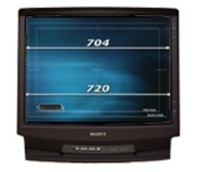Staff
![]()
Background
The DV-09 was Pioneer's no-holds barred approach to a DVD player. It is also one of the very first THX Ultra certified DVD players. We are strong supporters of THX and believe their goals for DVD player design and use are first rate. Unfortunately this player does not live up to the THX promise. One of the THX DVD player parameters is usability, and this player falls flat on its face in that regard, with video and audio quality not far behind.
Video
The video quality of the DV-09 is disappointing. This player has received numerous accolades, and we really don't understand why. We did get a chance to look at a second DV-09, and it performed identical to the one we tested so we know our test unit was not faulty.
Anyway, here are our test results:
This player improperly labels the CAV outputs as Y'Cb'Cr' and uses the inferior RCA connectors.
Black and White Levels
| Format | Black | White | Comments |
| CAV | 7.5 | 100.6 | Both the black level and white level are perfect. White is just a hair hot, but it's good. |
| YC | 6.5 | 100.3 | Black level is about 1 IRE low, but white is perfect. |
Color Bars
CAV
The Y portion of the CAV output closely matches Betacam® and EIA 770.1. It is slightly above on white and magenta and low on blue.
The Pb portion of the CAV output is just about equal to SMPTE and EIA 770.1. It is slightly low on Yellow and high on blue. The Pr portion of the CAV output is just slightly below SMPTE and EIA 770.1 on yellow, magenta, and red. It is slightly above on cyan, green, and blue.
Component Analog Video Data


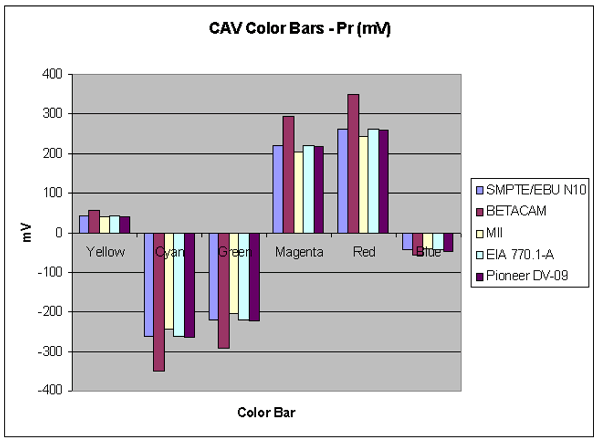
YC
The YC portion is very close to SMPTE 170M. It is just a hair high on white and yellow and a hair low on black. The rest are equal.
The chroma level is just a bit lower than SMPTE 170M. This player is not consistent with the other THX player in the Pioneer line, the DV-05. The chroma phase is just about perfect. It's a hair low on blue.
Composite/YC Data


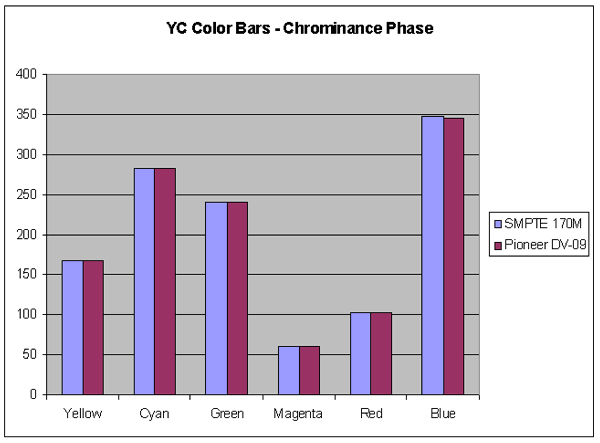
Video Frequency Response
The video frequency response is a bit unusual. It just barely peaks at 3 MHz on the CAV output.
The response dips at 2 MHz but then rises back up at 3 MHz. It begins to roll-off just after 3.58
MHz, and, at 5 MHz, the player is down –1.22 dB.
This ringing makes the player appear to be sharper than others, but it's not real information.
We actually found the ringing to be fatiguing after a while, and we ended up
looking at the false outlines instead of enjoying the movies. The measurements
were made with the detail settings in their default position.
Even though the response has very small peaks, there does appear to be an
excessive amount of ringing on the Avia sharpness pattern. We would blame the ringing on the video reconstruction filters.
We tried going through the entire range on the detail and sharpness controls
but could not eliminate the ringing. There was ringing on all of the
vertical and horizontal lines as well as the circles.
Video Frequency Response

Pixel Cropping
| Location | Pixels | Comments |
| Top | 0 | Excellent |
| Bottom | 0 | Excellent |
| Left | 4 | Very Good |
| Right | 5 | Very Good |
Signal-To-Noise Ratio
| Format | Output | SNR (dB) | Comments |
| CAV | Y | -71.2 | Very Good - The CAV SNR is very good to excellent. |
| CAV | Pb | -77.5 | Excellent |
| CAV | Pr | -78.0 | Excellent |
| YC | C-AM | -59.7 | Poor - The Noise levels on the YC outputs are very poor, so these outputs should not be used. |
| YC | C-PM | -44.3 | Very Poor - This DVD player has the worst YC SNR of all players tested. |
Component Channel Timing
| Channel | Timing (ns) | Comments |
| 'Pb' to Y | 32.2 | Poor |
| 'Pr' to Y | -42.2 | Poor |
| 'Pb' to 'Pr' | 74.4 | Very Poor - The player has a YC adjustment, but it only affects the relationship of Y to the color difference channels. 74ns is a complete pixel. The two color channels are sitting next to each other instead of on top of each other. This shows up as color fringing on the edges and smearing of fine detail. |
Audio
Audio Frequency Response
The audio frequency response of the DV09 from 20 Hz up to 4 kHz was excellent - flat as anyone could reasonably ask. Above 4 kHz, the frequency response was terrible. Compared to the DV-05, the DV-09 did have more output at 20 kHz, down only –0.15 dB. However, there's a sharp dip in the response at 10 kHz, where output is at -0.8 dB. Compared to the cheaper DV05, because the dip is in a range more audible to the human ear, the aberration may likely be more audible as well. If we recall correctly, this model was THX-Ultra certified, and used a questionable digital filter that Pioneer markets as Legato link. Not a favorable indication for either.
Audio Frequency Response
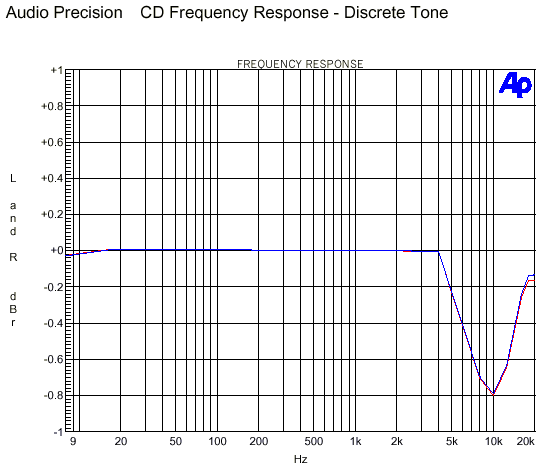
Harmonic Distortion + Noise FFT
The total harmonic distortion of the DV-09 was low enough, with the highest level at 8 kHz at –104 dB. What was discouraging, was that while we like to see the higher order distortion products disappear into the noise floor, becoming indistinguishable, the distortion products of the DV-09 stayed consistent in amplitude as the harmonics got higher and higher, all the way up to 20 kHz. Ugly. We would suggest using the digital output exclusively.
Distortion Spectrum

Wide-Band noise spectrum FFT (Wall AC)
The noise spectrum was reasonably good with plain old unconditioned, dirty AC. The highest levels were at 60 Hz and 180 Hz, at – 100dB and –110 dB respectively. Unlike the DV-05, the DV-09 had very little noise above the audible range.
Noise Floor (Wall)
.gif)
Wide-Band noise spectrum FFT (Lab grade AC)
The noise floor did not substantially improve with regenerated AC, which means that what noise is present at the analog outputs, is mostly inherent to the player.
Noise Floor (Lab)
.gif)
Low-Level DAC Linearity
The low-level DAC linearity looks pretty much the same as the DV-05, implying similar construction parts. There's the same dip at -85 dB, another dip at –92 dB, with an error of -0.8 dB, saved only by the noise content to plot to –97 dB within ± 1 dB of linearity error. It's all right, but nor particularly good for modern digital gear.
DAC Linearity
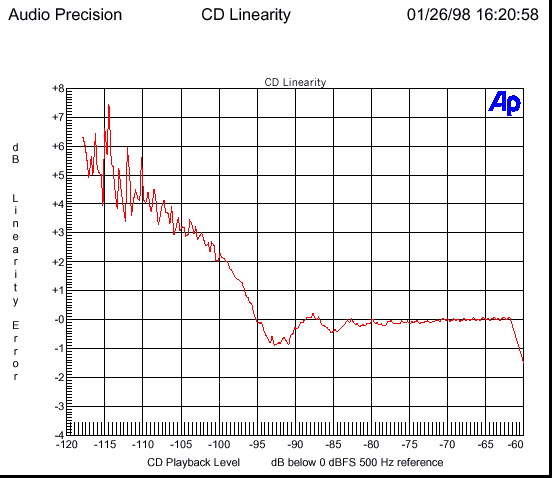
Dynamic Range
94.8 dB - not horrible, but not great.
Inter-Modulation Distortion
-114.4 dB - probably one of its better performance parameters.
Functionality
Note: A green check in the boxes below means that feature worked OK. A red X means it is unsatisfactory.
Avia
| Test | Results | Comments |
| Subpicture |
|
|
| Slide Show |
|
Video Essentials
| Test | Results | Comments |
| Blacker-Than-Black |
|
|
| Stress Test |
|
WHQL
Subpicture Palette (DCS)
| Test | Results | Comments |
| Still |
|
|
| Bob |
|
|
| Weave |
|
Default Palette Color Index
| Test | Results | Comments |
| Still |
|
|
| Bob |
|
|
| Weave |
|
Custom Palette Color Index
| Test | Results | Comments |
| Still |
|
|
| Bob |
|
|
| Weave |
|
Branching
| Test | Results | Comments |
| Seamless Branching |
|
This player performs as expected and branches in two clock sweeps. |
| Multiple Angles |
|
This player takes between 1.5 and 2 seconds to change angles. |
Menu
| Test | Results | Comments |
| Loops |
|
|
| Ends |
|
Field/Frame Freeze
| Test | Results | Comments |
| Weave |
|
|
| Bob |
|
No Valve - This player is delivering a freeze frame when it should not. |
16x9 Menu
| Test | Results | Comments |
| Letterbox |
|
|
| Widescreen |
|
Cropping
| What it should look like | What it does look like |
Click on the images above to see a close-up of what the error looks like.
| Test | Results | Comments |
| 352x240 |
|
|
| 720x480 |
|
|
| 704x480 | ||
| 352x480 | Image is squeezed and centered. You can see the image up at the top. Click on image (above right) for a close-up. |
Layer Break
This player was slow at changing layers. It takes between 2.5 and 3 seconds to complete a layer change.
| Test (DVD) | Results | Comments |
| "Cruel Intentions" |
|
|
| "Ghostbusters" |
|
|
| "Friend" VCD | ||
| "Saving Private Ryan" (DTS) | ||
| "The Abyss" | ||
| Chesky Super Audio 96/24 | You select if you want the digital output to provide 96 kHz or if you want it down-converted to 48 kHz. |
Physical Response
This player falls on the slower half of the scale. I gave it a 4.
| Test | Results | Comments |
| Setup |
|
|
| Transcode |
|
|
| CD-R |
Error Correction/Concealment
Pierre Vareny
This player fell at the bottom of the list when it came to CD error correction. It is even lower than the DV-05. It can play up to and including chapter 29, which represents a 0.50mm gap.
Scratch the Dog
This player is pixilated at chapter 2 and dies at chapter 4.
Usability
Pioneer should know better than to design remote controls like this. This is one of the bottom dwellers of all the remotes we tested. It illustrates how not to design a remote so that people can use it without error. It also has a jog/shuttle control which is a waste of remote resources for the vast majority of DVD viewers.
The Remote Score = 2 out of 11. The image gives you an indication how the Pioneer designers have considered the usability of the remote.
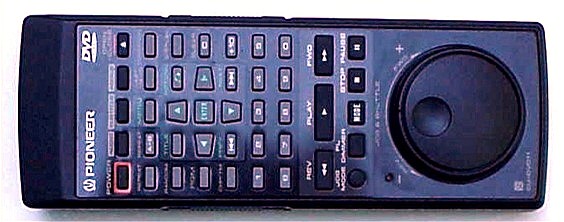
We established our rating scheme in the usability article with the Eleven Tenets of Remote Design. Each one of the principles gets the player 1 point, so the maximum possible score would be 11. See the comments for each of the design tenets.
| Test | Results | Comments |
| Button Access |
|
The buttons are too close together, and it is hard to hit one without accidentally hitting another nearby button. When you are using a remote you are not as attentive as you are when doing more attention demanding tasks (like putting another hard drive in your TiVo). You want to be able to perform the task without thinking about it too much. This remote makes you think too much about not making an error. |
| Minimal number of buttons |
|
Just look at it. This remote has every button you will never need at the expense of leaving room for the jog/shuttle. |
| Distinctive buttons | If it were possible to give a negative score here, we would. These buttons are almost all identical. The remote is impossible to use in the dark. In fact, it is hard to use in anything but really bright light. The buttons are a light gray color with light green text. | |
| Appropriately sized buttons | The designers have not differentiated between the buttons, making it difficult to pick out the buttons that you will use most frequently. | |
|
Good tactile feedback |
The buttons are low profile and too mushy for our tastes. | |
|
Fits well in a single hand |
The remote is too wide to be held in a single hand. It also has a very boxy shape, which makes it a bit uncomfortable to hold. Haven't these folks used remotes in the past? How can you finish with a remote like this and say to yourself, “There's a job well-done?” | |
| Right/Left Handed | The controls are centered in the remote, but you will use this remote with both hands. | |
| Backlighting | Are you kidding? Adding a backlight would have made this remote a bit easier to use. That's just not in the cards, we guess. | |
|
Indication of control mode |
||
|
Standard naming |
Luckily, they did not take license with the standard control names. | |
|
Player feedback |
The Bottom Line on Usability
I would never recommend a player whose designers felt this was an adequate remote. The remote is the way you communicate with your player, and this one will leave you wanting for something more.
- Staff -
| DVD Benchmark Explanatory Articles | |||
| Part 3 - Functionality | Part 4 - Usability | Part 5 - Progressive Scan |
Return to Table of Contents for this Issue.

